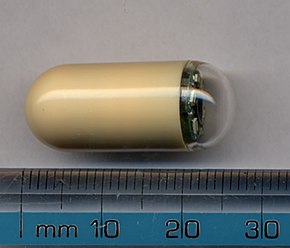| Wireless Capsule Endoscopy | |
|---|---|
 Picture of a capsule | |
| MeSH | D053704 |
| OPS-301 code | 1-63a, 1-656 |



Capsule endoscopy is a medical procedure used to record internal images of the gastrointestinal tract for use in disease diagnosis. Newer developments are also able to take biopsies and release medication at specific locations of the entire gastrointestinal tract.[1] Unlike the more widely used endoscope, capsule endoscopy provides the ability to see the middle portion of the small intestine. It can be applied to the detection of various gastrointestinal cancers, digestive diseases, ulcers, unexplained bleedings, and general abdominal pains. After a patient swallows the capsule, it passes along the gastrointestinal tract, taking a number of images per second which are transmitted wirelessly to an array of receivers connected to a portable recording device carried by the patient. General advantages of capsule endoscopy over standard endoscopy include the minimally invasive procedure setup, ability to visualize more of the gastrointestinal tract, and lower cost of the procedure.[2][medical citation needed]
- ^ "Diagnostics with a Stomach Pill" (PDF). Max Planck Institute for Intelligent Systems. January 7, 2016. Archived (PDF) from the original on 2017-03-21.
- ^ "The endoscopy procedures we provide". 28 November 2018. Farzan Bahin, The Hills Gastroenterology, Sydney, Australia.